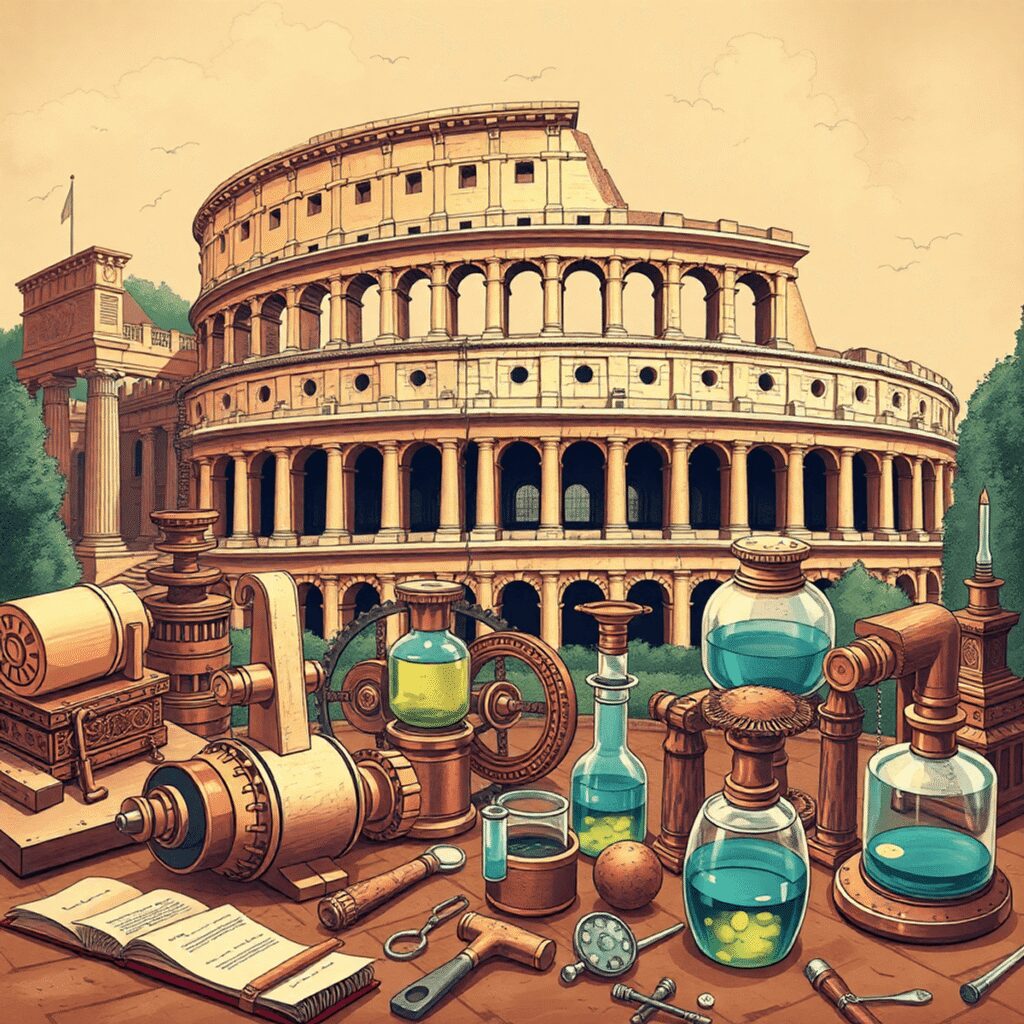Ancient Rome science is often celebrated for grand architectural feats and engineering marvels. Yet, many of its forgotten experiments hold equally transformative historical impact. These early scientific endeavors, though overshadowed by monumental constructions and political history, reveal a sophisticated understanding of materials, chemistry, and physics.
Rediscovering these lesser-known Roman experiments opens doors to valuable insights that continue to influence modern research and innovation. From unique metalworking techniques to experimental uses of natural resources, the Romans laid groundwork that contemporary science still builds upon.
In this article, you will learn about:
- The broad scientific legacy of Ancient Rome beyond common knowledge
- How Roman lead became an indispensable material in cutting-edge physics research
- The delicate balance between preserving archaeological heritage and advancing scientific progress
- Other overlooked Roman scientific practices that changed history
Exploring these topics sheds light on how ancient experiments remain relevant today.

The Scientific Legacy of Ancient Rome
Ancient Rome made significant contributions to the world through its innovative use of materials and advancements in engineering. Here are some key aspects to consider when exploring the scientific legacy of Ancient Rome:
1. Overview of Roman Innovations
Roman technology was advanced for its time, with impressive achievements in materials science and engineering. They demonstrated a mastery of materials that shaped their world through various projects, including:
- The construction of aqueducts
- The building of extensive road networks
- Architectural marvels like the Colosseum
2. Foundations for Future Advances
The cleverness shown by the Romans laid the groundwork for future scientific progress. One notable example is their innovations in concrete, which transformed construction methods and continue to be studied today for their durability and strength.
3. Embedded Scientific Knowledge
Roman scientific knowledge extended beyond grand architectural endeavors and influenced everyday life as well. Their advancements in metallurgy, such as creating stronger alloys for weapons or developing intricate glasswork, demonstrated a profound understanding of materials and their properties.
By exploring the scientific legacy of Ancient Rome, we gain valuable insights into how ancient civilizations pushed the limits of what could be achieved with the available resources.

Ancient Roman Lead: A Unique Scientific Resource
Uses of Lead in Ancient Rome
Lead was an important metal in Ancient Rome, used for various purposes:
- Coins: The Romans used lead to create their currency, reflecting the metal’s widespread availability and ease of use for minting coins.
- Pipes: Lead pipes were a common feature in Roman aqueducts and plumbing systems, showcasing the durability and malleability of this material.
- Construction: Lead was also utilized in construction for roofing and as a sealant due to its waterproof properties.
Why Roman Lead is Uniquely Pure and Low in Radioactivity Today
Ancient Roman lead artifacts have been found to be remarkably pure compared to contemporary sources. This purity is attributed to the smelting techniques employed by the Romans, which inadvertently reduced impurities.
The low radioactivity of ancient Roman lead is a result of the natural decay process over centuries. Radioactive isotopes present in freshly mined lead diminish over time, making historical lead ideal for certain scientific applications today.
The Natural Decay Process That Makes This Possible
Through the radioactive decay of isotopes like uranium and thorium present in lead ores, the radioactivity levels decrease gradually over millennia. This long-term decay process renders ancient Roman lead exceptionally low in radioactivity compared to modern sources. Furthermore, the unique properties of ancient Roman lead, such as its purity and low radioactivity, make it a valuable resource for various scientific research areas, including geochemical studies.

The Role of Roman Lead in Modern Physics Experiments
Particle physics experiments require low background radiation shielding to accurately detect rare particles. Ancient Roman lead’s exceptional purity and low radioactivity make it an ideal material for shielding in modern physics research.
Why Low Background Radiation Shielding Matters
Sensitive particle physics experiments demand precise detection capabilities, which require shielding materials with minimal background radiation interference. Any additional radiation present can obscure the signals from the particles being studied, making it difficult to identify and analyze them.
Roman Lead’s Unique Properties
Ancient Roman lead is known for its remarkable purity and low radioactivity levels. These characteristics make it an excellent choice for shielding in experiments where even the slightest amount of background radiation could compromise the results.
Applications in Prominent Experiments
Roman lead has found practical application as a shielding material in several significant particle physics experiments:
- Cryogenic Dark Matter Search (CDMS): This experiment aims to directly detect dark matter particles by observing their interactions with ordinary matter.
- Cryogenic Underground Observatory for Rare Events (CUORE): CUORE seeks to investigate neutrinoless double beta decay, a process that could provide insights into the nature of neutrinos and the asymmetry between matter and antimatter.
Importance for Detecting Elusive Particles
The use of Roman lead in these experiments holds great significance for uncovering elusive particles such as dark matter and neutrinoless double beta decay. These phenomena have long puzzled scientists, and their discovery could revolutionize our understanding of the universe.
By incorporating ancient Roman lead into modern physics experiments, researchers can delve deeper into understanding fundamental particles and phenomena that have eluded detection thus far. This unique synergy between historical resources and cutting-edge technology exemplifies how ancient knowledge continues to shape scientific advancements today.

Balancing Archaeological Preservation and Scientific Progress
The use of ancient Roman lead ingots in modern physics experiments raises significant questions about artifact preservation versus scientific advancement. This tension arises because these ingots are more than just materials; they are valuable archaeological artifacts that hold keys to understanding Roman industry, trade, and technology.
Archaeological Concerns
Archaeological concerns focus on the loss of cultural heritage when artifacts are repurposed for scientific use. Roman lead ingots often bear inscriptions, stamps, or markings that provide insights into their origin and the socio-economic context of the Roman Empire. Removing or altering these artifacts for experimental shielding can erase important historical data. Preservationists argue that maintaining these artifacts intact allows future generations to study and appreciate ancient craftsmanship and economic systems.
Scientific Perspective
On the other hand, scientists emphasize that Roman lead’s unique low radioactivity makes it irreplaceable for certain sensitive experiments. Its scarcity means that new sources cannot easily substitute it without compromising experimental integrity. This creates a practical dilemma: prioritizing scientific progress might require sacrificing some archaeological evidence.
Ethical Debates
Ethical debates emerge around:
- The extent to which artifacts can be altered or consumed in research
- Ensuring transparent collaboration between archaeologists and scientists
- Developing guidelines that respect both cultural heritage and scientific needs
Balancing these interests demands careful consideration, recognizing the cultural significance of Roman lead ingots alongside their critical role in advancing fundamental physics research.

Forgotten Roman Science Experiments Beyond Lead
Ancient experiments in Roman times extended well beyond the use of lead. The Romans applied advanced scientific methods to metallurgy, hydraulics, and construction—areas where much of their lost knowledge remains hidden or underestimated.
1. Metallurgy Techniques
Roman smiths developed sophisticated processes for alloying metals like bronze, iron, and gold. Techniques such as cupellation (refining silver by removing lead) and quenching methods for steel show an empirical understanding of material properties. These practices laid groundwork for later metallurgical advancements in the Middle Ages and Renaissance.
2. Early Hydraulics
The Romans engineered complex water management systems including aqueducts, pumps, and drainage solutions. Their use of siphons and water wheels demonstrates experimental approaches to fluid dynamics. These innovations influenced medieval hydraulic engineering and modern water supply infrastructure.
3. Glassmaking and Pigments
Experimentation with high-temperature furnaces enabled production of clear glass and durable pigments. These early chemical experiments contributed to later developments in chemistry and optics.
Roman scientific methods often combined practical application with repeated experimentation, even if not formalized by modern standards. This hands-on approach allowed them to iterate on designs and materials effectively.
The influence of these forgotten experiments extends into modern science and industry by providing foundational principles that persisted through centuries. Rediscovering these ancient techniques could inspire innovative solutions today, reminding us that much valuable knowledge lies buried within history’s neglected chapters.
The Intersection of Ancient Technology and Cutting-edge Science
The link between ancient and modern science is a fascinating area of study that shows how technological influence from the past can shape contemporary research. One notable example is the use of ancient Roman lead in modern physics experiments, highlighting the interdisciplinary nature of scientific exploration.
Case Study: Ancient Materials in Modern Research
Researchers have used ancient Roman lead ingots as shielding materials in advanced physics experiments. The unique purity and low radioactivity of this lead make it extremely valuable for sensitive particle detectors.
Broader Implications for Innovation
Studying ancient technologies offers insights that can inspire breakthroughs in various scientific fields. By looking into forgotten scientific experiments of Ancient Rome, researchers can find new ways to tackle present-day problems.
This connection between past discoveries and present advancements shows how historical experimentation continues to influence the direction of scientific inquiry.
Conclusion
Preserving the legacy of Roman science is crucial for understanding our historical influence on modern research.
The Forgotten Science Experiments of Ancient Rome That Changed History emphasize the ongoing dialogue between past and present scientific endeavors.
FAQs (Frequently Asked Questions)
What are some of the key scientific contributions of Ancient Rome?
Ancient Rome made significant contributions to science and technology, including innovations in materials engineering, metallurgy, and hydraulics. These advancements laid foundational knowledge that influenced future scientific developments and were embedded in daily Roman life.
Why is ancient Roman lead considered unique and valuable for modern scientific research?
Ancient Roman lead is uniquely pure and exhibits low radioactivity due to natural decay processes over centuries. This makes it an exceptional material for sensitive particle physics experiments requiring low background radiation shielding, such as the Cryogenic Dark Matter Search (CDMS) and CUORE experiments.
How is ancient Roman lead used in contemporary physics experiments?
Roman lead ingots serve as critical shielding material in advanced particle physics experiments like CDMS and CUORE. Their low radioactivity helps reduce background noise, enabling the detection of rare particles such as dark matter and neutrinoless double beta decay.
What ethical considerations arise from using ancient artifacts like Roman lead for modern science?
There is a delicate balance between archaeological preservation and scientific progress. Using ancient artifacts for research can conflict with preserving cultural heritage. Ongoing debates focus on respecting the historical significance of Roman lead ingots while harnessing their unique properties for cutting-edge science.
Are there other forgotten scientific experiments or techniques from Ancient Rome beyond the use of lead?
Yes, Ancient Rome had several overlooked scientific practices including advanced metallurgy techniques and early hydraulic engineering. These forgotten experiments influenced later scientific thought and industrial processes, highlighting the depth of Roman innovation beyond commonly recognized achievements.
How does studying ancient Roman technologies inspire modern scientific innovation?
Exploring ancient materials and methods reveals interdisciplinary links between past and present science. Case studies demonstrate how ancient resources like Roman lead enable breakthroughs in modern physics, emphasizing that rediscovering forgotten experiments can provide valuable insights to drive contemporary research and technological advancement.

